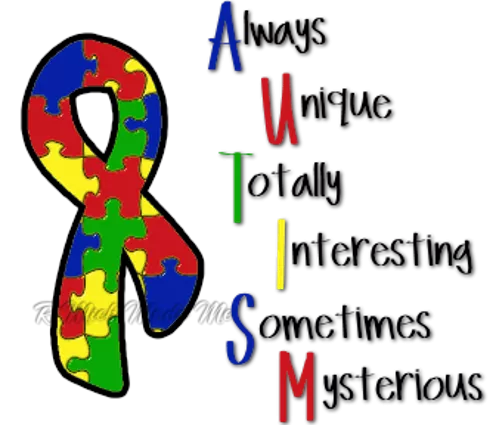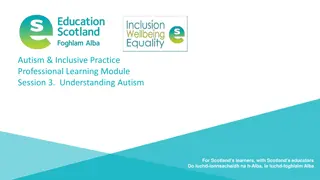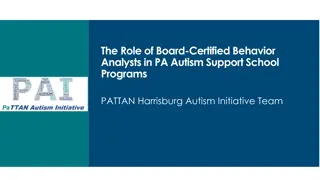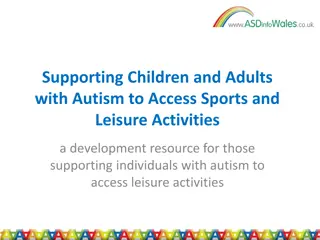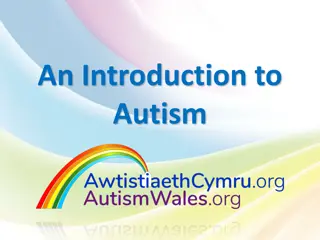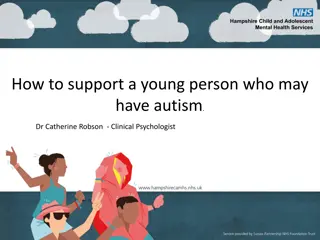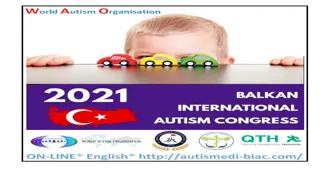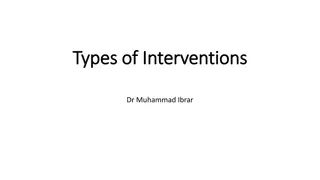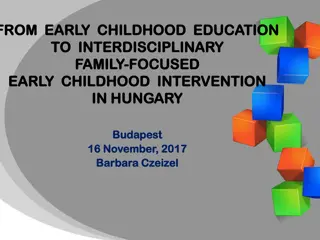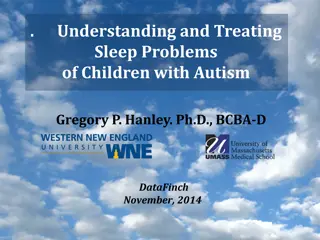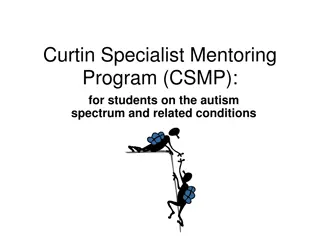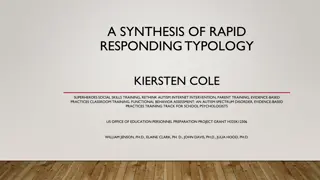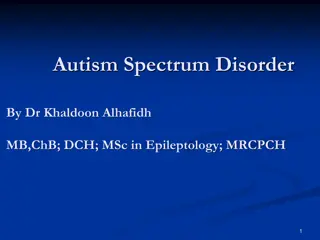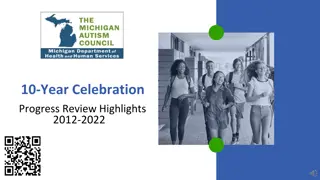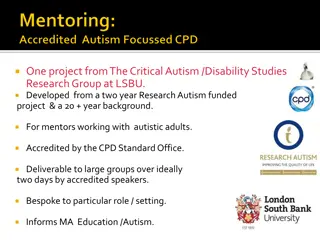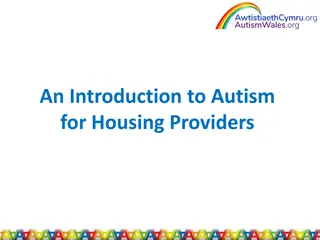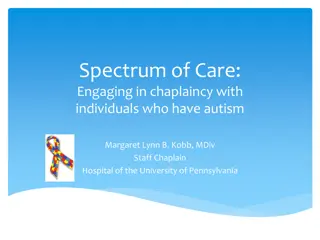Critical Review of Autism Early Intervention Approaches
This content explores the effectiveness of different early intervention approaches for children with autism, including the Picture Exchange Communication System (PECS) and the Hanen More Than Words (MTW) program. Studies and meta-analyses provide insights into these approaches' impact on social communication skills, parent participation, vocabulary size, and stress levels. While MTW shows potential for increasing vocabulary size, it does not consistently improve overall social communication skills. PECS demonstrates some efficacy in improving communication and speech for children with autism spectrum disorders.
Download Presentation

Please find below an Image/Link to download the presentation.
The content on the website is provided AS IS for your information and personal use only. It may not be sold, licensed, or shared on other websites without obtaining consent from the author.If you encounter any issues during the download, it is possible that the publisher has removed the file from their server.
You are allowed to download the files provided on this website for personal or commercial use, subject to the condition that they are used lawfully. All files are the property of their respective owners.
The content on the website is provided AS IS for your information and personal use only. It may not be sold, licensed, or shared on other websites without obtaining consent from the author.
E N D
Presentation Transcript
Autism EBP group First meeting held in September 2010 56 group members, broad range of SPs in disability, community, ADHC, private practice, autism-specific preschools, specialised (e.g. ASPECT, ABI, CP), NGOs etc.
Critically Appraised Topics In children less than 3 years of age with autism who are preverbal, does a Hanen MTW approach compared to a PECS approach result in improved social communication skills? In children with autism, does video instruction improve the effectiveness of social communication skills? In children with autism, does the use of i technology (e.g. ipads, iphones) result in improved social communication skills?
PECS vs MTW Flippin M., Reszka S., & Watson L. (2010). Effectiveness of the Picture Exchange Communication System (PECS) on Communication and Speech for Children with Autism Spectrum Disorders: A Meta-Analysis. American Journal of Speech and Language Pathology, 19, 178-195. Level - IV McConachie H., Randle V., Hammal D. & Le Couteur A. (2005). A controlled trial of a training course for parents of children with suspected autism spectrum disorder. The Journal of Pediatrics, 147, pp 335-340. Level - III Carter A. S., Messinger D. S., Stone W. L., Celimi S., Nahmias A. D. & Yoder P. (2011). A randomized controlled trial of Hanen s More Than Words in toddlers with early autism symptoms. Journal of Child Psychology and Psychiatry 52 (7), 741-752. Level - II Girolametto L., Sussman F., & Weitzman E. (2007). Using case study methods to investigate the effects of interactive intervention for children with autism spectrum disorders. Journal of Communication Disorders, 40, 470-492. Level - IV
More Than Words Bottom Line There is some evidence that parent participation in MTW may result in an increase in vocabulary size though a causal link cannot be proven. There is not enough evidence to demonstrate that participation in MTW improves overall social communication skills.
Interesting Findings - MTW No improvement in social communication (ADOS as a measure) McConachie et. al (2005). Increase in parents use of facilitative strategies McConachie et. al (2005). No difference in parent stress level McConachie et. al (2005). MTW did not benefit all children Carter et al (2011) Increase in parent responsivity noted but not statistically significant and not maintained Carter et al (2011) Gains in JA for children <3 with limited object interest Carter et al (2011) Best outcomes reported by Girolametto et al (2007) creators of Hanen programs Level IV study 3 subject pre test and post test design
PECS Bottom Line There is some evidence that participation in a PECs intervention increases children s social communication skills (measured by frequency of PECS exchanges, requests and initiations) but those few studies who looked at generalisation and/or maintenance found the evidence was not strong and most children regressed. There was no evidence that PECs was beneficial to children specifically under 3 years, as the studies included children up to age 18.
Interesting Findings - PECS Vocalizations generally developed in the later phases of PECs training (i.e. stages 4-6) (Bondy & Frost 1994) Sign language was found to be a more effective intervention than PECS (Tincani 2004). PECS was more effective in targeting communication outcomes for children who had lower frequencies of joint attention (Charlop-Christy et al). Variable effects in PECS program showed that the program was not equally effective in improving speech outcomes for all children with autism (Flippin et al 2010).
PECS vs MTW Bottom Line There is not adequate evidence to support the claim that either PECs or MTW interventions are effective in improving social communication skills in children under 3 that are maintained beyond the treatment period. Neither therapy intervention appears to be equally effective for all children with autism, but may benefit subgroups of children with autism (MTW Children <3 with limited object interest, PECS children with lower frequencies of joint attention) Further research is needed to determine whether these therapies may be effective in increasing social communication skills in children under 3 with autism who have specific communication deficits.
Video Modeling Video modeling (VM) a child is shown a video which depicts a desired behaviour in an appropriate context, and then asked to imitate the behaviour. A peer, sibling or adult may be used to model the behaviour or... Video self modeling (VSM) video is taken of the child successfully performing a behaviour Point of view video modeling (PVM) video is shot as if through the eyes of the child showing what they would see in the situation
Video Modeling Bellini S., & Akullian J. (2007). A Meta-Analysis of Video Modeling and Video Self-Modeling Interventions for Children and Adolescents with Autism Spectrum Disorders. Exceptional Children, 73, 3, 264-287. Shukla-Mehta S., Miller T., & Callahan K. (2010). Evaluating the Effectiveness of Video Instruction on Social and Communication Skills Training for Children with Autism Spectrum Disorders: A Review of the Literature. Focus on Autism and Other Developmental Disabilities, 25:23.
Evidence Both studies were reviews of existing studies Smita Shukla Mehta reviewed 26 studies published between 1980 2008 (total 104 participants) 25 - single subject research design (multiple baseline or multiple probe). inc. 1-7 children (mean 3.16) 1 matched random group comparison w/ 25 children (Kroeger, Schultz & Newsom 2007). Belini & Akullan reviewed 23 studies published between 1980 2005 (total 73 participants ) 22 multiple baseline or probe design and 1 reversal design. inc. 1-7 children (mean 3.55) Overlap between reviews 13 articles included in both
Video Modeling Bottom Line Some evidence exists to support the use of videomodeling to improve social communication skills in autism (Smita Shukla-Mehta et al 2010, Bellini & Akullan 2007). Due to inconsistencies in intervention across existing studies, Smita Shukla-Mehta et al suggested a clearer delineation of the aspects of intervention is needed in future research to determine whether videolmodeling can be considered evidence based intervention
Guidelines for Effective Video Instruction Use instructional prompts and reinforcers or error correction Need to evaluate child s skills (attention, imitation, visual processing, comprehension, matching to sample, and spatial ability) to determine amount of content and length of video Children more likely to benefit if able to attend to a video for at least 1 minute Keep video clip between 3 and 5 minutes and view twice (more if children reinforced by watching videos) Type of model does not appear to matter, though VSM appears to be less efficient than VM Smita Shukla-Mehta et al 2010 1. 2. 3. 4. 5.
But wheres the evidence? Our clinical question: In children less than 5 years with an ASD, does the use of i-technology (eg. iPads, iPhones) result in improved social communication skills? Single Research Paper: Flores, M. et al (2012) A comparison of Communication using the Apple iPad and a Picture Based System. Augmentative and Alternative Communication. 1-11
Results Communication behaviours either increased when using the iPad or remained the same as when using PECS
Interestingly Technology is moving faster than our researchers: 2012 paper may be out of date Media coverage focused on using Proloquo2Go as a communication device only emerging research for this Aspect is doing Australian research on a number of apps Proloquo2Go is one of these Hundreds of apps on the app store targeting autism Searched for autism in the App store and over 648 apps Designed by web designers, speech pathologists, parents, teachers?
Our Workplaces are committed Sent a survey out to all members of the EBP committee 25 responses 19 staff members have access to an iPad (15 are work iPads, 5 use their own) Common trends: Some had work iPads but unable to use or download apps to them due to IT difficulties (harder in bigger workplaces) Using iPads as rewards, additional skills not just AAC Using best practice strategies (eg. Schedules) on the iPad
The social world is changing Sheldon and Amy hanging out
Bottom line: 2012 research article is already out of date More research required Specific to apps rather than iPad in general
Future directions Next topic will look at therapy targeting play skills in children with autism Continue to meet at Croydon 5 x per year. Dates have now been set. Please contact leaders for details.
Thank you Amanda Brignell for keeping the group together while I was gone, and Ann Linich for all her help Group members for sharing the job of compiling the CAPs and another very productive year Carissa Louwen for organising the room bookings Julia Bye for helping out while Amanda is on secondment And of course, Anita for helping so much with our presentation today













